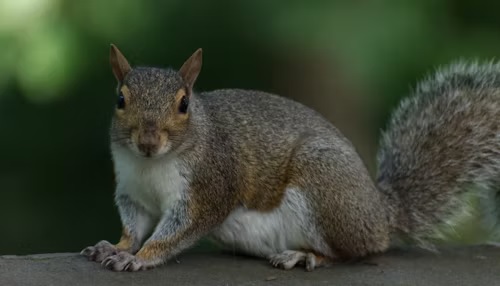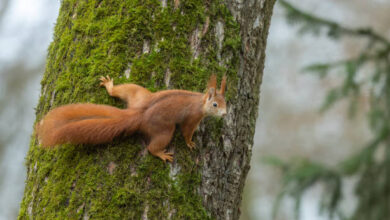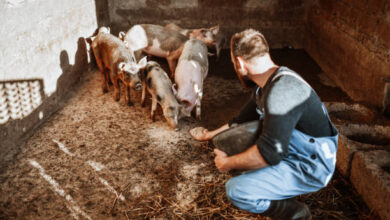
Are Squirrels Nocturnal Animals? Their Behavior and Habits
Have you ever spotted a squirrel darting across your yard in the early morning or late afternoon and wondered, “Do these animals come out at night?” Understanding squirrel behavior can provide valuable insights into their daily routines and habits. In this blog post, we’ll explore whether squirrels are nocturnal animals, compare their activity patterns with those of truly nocturnal creatures, and go into factors that influence their behavior.
Squirrel Activity Patterns
Daytime Behavior of Squirrels
Squirrels are predominantly diurnal animals, meaning they are active during the day and rest at night. Most squirrels are seen foraging, climbing trees, and building nests in daylight hours. Their daily activities revolve around finding food, interacting with other squirrels, and maintaining their nests, or dreys.
– Foraging: Squirrels spend a significant portion of their day searching for nuts, seeds, and other food sources to store for later use. This activity is crucial for their survival, especially as winter approaches.
– Nesting: Building and maintaining nests is another important daytime activity. Squirrels use their agility to construct and repair their dreys, ensuring a safe and warm place to sleep.
Comparison with Nocturnal Animals
Unlike nocturnal animals, which are adapted to be active during the night and rest during the day, squirrels do not possess the same adaptations. Nocturnal animals, such as owls and bats, have specialized senses and physical traits that allow them to thrive in low-light conditions. For example:
– Enhanced Night Vision: Nocturnal animals often have larger eyes relative to their body size to maximize their ability to see in the dark.
– Sensitive Hearing: Many nocturnal creatures have highly developed hearing to detect prey or predators during nighttime.
Squirrels, on the other hand, have eyes adapted for daylight vision and rely on their keen sense of smell and hearing for daytime activities.
Squirrel Species and Their Habits
Eastern Gray Squirrel
The Eastern gray squirrel, one of the most common species in North America, is active mainly during the day. These squirrels are known for their adaptability and can often be seen in urban and suburban environments.
– Daily Patterns: Eastern gray squirrels typically start their day early and remain active until dusk. They are known for their agility and frequent tree-climbing.
Fox Squirrel
The Fox squirrel is another diurnal species, similar in its activity patterns to the Eastern gray squirrel. However, it tends to prefer more rural and wooded areas.
– Behavioral Differences: Fox squirrels may exhibit slightly different behaviors depending on their habitat, but they also follow a primarily daytime schedule.
Other Squirrel Species
While the Eastern gray and Fox squirrels are diurnal, some species in different regions may have variations in their activity patterns. For example:
– Red Squirrel: Found in forested areas, red squirrels have similar daytime activity patterns but may be more secretive and less visible.
– Flying Squirrel: Unlike their tree-dwelling relatives, some flying squirrels, like the Southern flying squirrel, are more active at dusk and during the night, making them semi-nocturnal.
Factors Affecting Squirrel Behavior
Food Availability
Food resources play a crucial role in shaping squirrel behavior. During periods of abundant food, squirrels are more likely to be active during the day to gather and store supplies. Conversely, food scarcity can lead to changes in their activity patterns.
– Seasonal Variations: In fall, when food is plentiful, squirrels are busier during the day to prepare for winter. In contrast, during winter, they may limit their activity to conserve energy.
Weather and Seasonal Changes
Weather conditions and seasonal changes significantly influence squirrel behavior. Cold temperatures and heavy snow may force squirrels to limit their outdoor activity and rely more on their stored food supplies.
– Impact of Seasons: Squirrels adjust their behavior based on the season, with increased daytime activity during warmer months and reduced activity during harsh winters.
Urbanization and Habitat Changes
Urbanization and habitat changes can also affect squirrel behavior. In cities, squirrels may adapt to human activity patterns, sometimes becoming more active during times when human activity is low, such as early mornings or late evenings.
– Adaptation to Urban Environments: Urban squirrels might adjust their routines to navigate the challenges of city life, such as finding food and avoiding predators.
YOU MAY LOVE TO READ
What Animal Has the Best Sense of Smell?
Which Animal is the Dumbest? Least Intelligent Animal
Observing Squirrel Behavior
Tips for Observing Squirrels
Observing squirrels can be a fascinating way to learn more about their behavior. To get the best view of their daily activities:
– Best Times: Early morning and late afternoon are ideal times to watch squirrels, as they are most active during these periods.
– Quiet Observation: Approach quietly and maintain a safe distance to avoid disturbing them.
Tools and Techniques
Using binoculars or a camera with a zoom lens can enhance your observation experience. Noting their behavior patterns and interactions can provide additional insights into their daily routines.
– Binoculars: Useful for observing squirrels from a distance without disturbing them.
– Recording Behavior: Keeping a journal or using a wildlife camera can help track and analyze their activity patterns.
Common Misconceptions About Squirrel Behavior
Myth vs. Fact
A common misconception is that all squirrels are nocturnal. In reality, most squirrel species are diurnal. The confusion may arise from sightings of squirrels during twilight hours, which can be due to variations in light or activity patterns.
Scientific Observations
Scientific studies and observations confirm that the majority of squirrel species, including the Eastern gray and Fox squirrels, follow a daytime activity pattern. Exceptions like the flying squirrel highlight the diversity in behavior among different species.
Conclusion
Squirrels are not nocturnal animals; they are primarily diurnal, meaning they are most active during the day. By understanding their activity patterns, species differences, and the factors influencing their behavior, you can gain a deeper appreciation for these fascinating creatures. Have you observed squirrels in your area? Share your experiences in the comments below! And don’t forget to explore our other wildlife articles for more intriguing insights.




